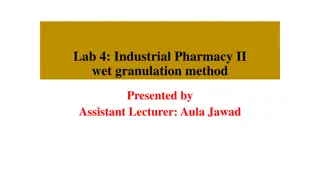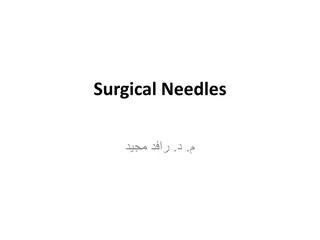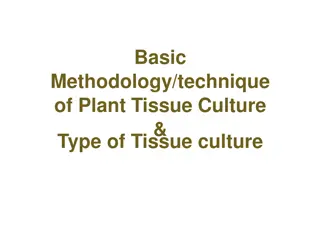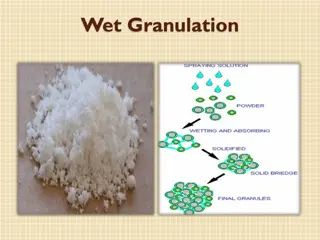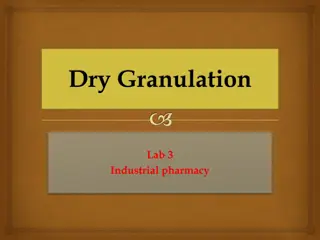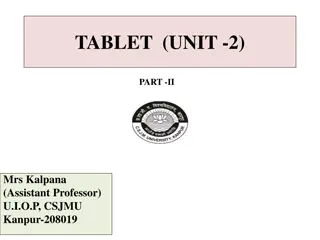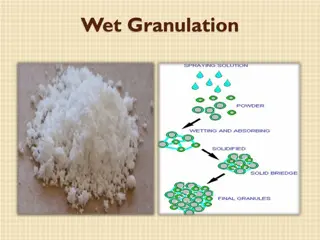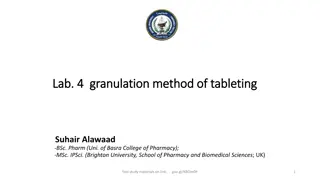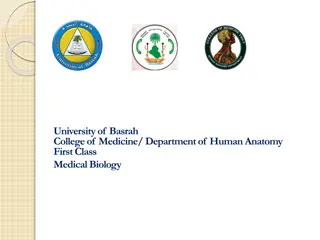Understanding Extracellular Matrix (ECM) and Its Functions
Extracellular Matrix (ECM) is a complex network of proteins, glycoproteins, and macromolecules that provide structural support, regulate cell activities, and play crucial roles in various tissues. It consists of two main types - interstitial matrix and basement membrane, each serving specific functi
12 views • 25 slides
Overview of JPAC: United Kingdom Blood Transfusion and Tissue Transplantation Services
JPAC, the Joint United Kingdom (UK) Blood Transfusion and Tissue Transplantation Services Professional Advisory Committee, plays a crucial role in providing guidelines and ensuring standardization and safety in the field of blood transfusion. Established in the late 1980s, JPAC has evolved to become
1 views • 33 slides
Advancing Healthcare: Potential of Advanced Amniotic Tissue by Life Biologics
Life Biologics is at the forefront of using amniotic tissue to develop premium human amniotic tissue grafts for advanced wound care. Our innovative products offer patients a comprehensive range of treatment options. Life Biologics' advanced skin substitutes provide a revolutionary solution for both
0 views • 5 slides
Exploring Symbolism and Connections in "Tissue" by Imtiaz Dharker
This analysis delves into the symbolism present in Imtiaz Dharker's poem "Tissue," drawing connections between paper, human skin, and architecture. The poem reflects on the fragility of human power through the metaphor of tissue and explores the intricate layers that make up an individual's identity
0 views • 23 slides
Understanding Plant Tissue Culture: Methods and Requirements
Plant tissue culture involves the in-vitro culture of plant explants under aseptic conditions, covering cell, organ, and suspension cultures. This process, pioneered by German botanist Gottlieb Haberlandt, relies on the totipotency of plant cells. Key requirements include laboratory organization, su
0 views • 18 slides
Understanding Hypermobility and Connective Tissue Disorders in Children
Hypermobility is a common condition affecting joints, often without significant difficulties. However, in cases like Ehlers-Danlos syndrome and Marfan syndrome, connective tissue disorders with specific symptoms can impact daily life. Learn about the signs, symptoms, management, and the role of a ph
0 views • 11 slides
Understanding Plant Tissue Culture Media and Their Importance in In Vitro Growth
Plant tissue culture media play a crucial role in the in vitro growth and morphogenesis of plant tissues. The composition of culture media depends on the specific plant species and the type of material used for culture. Various types of media, such as White's medium, MS medium, B5 medium, N6 medium,
0 views • 6 slides
Understanding Repair by Connective Tissue in Healing Processes
Healing or repair by connective tissue occurs in response to severe or chronic tissue injuries, leading to the replacement of nonregenerated cells with connective tissue or scar formation. This process involves the induction of fibroblast and endothelial cell proliferation, granulation tissue format
3 views • 26 slides
Understanding Inflammation and Its Characteristics
Inflammation is the response of tissues to harmful agents, categorized as acute or chronic. Acute inflammation is rapid and short-lived, while chronic inflammation is insidious and prolonged. Chemical mediators play a crucial role in both forms, leading to tissue necrosis. The five cardinal signs of
3 views • 27 slides
Understanding Inflammation and Repair in Tissue Response
Inflammation is a crucial process in response to tissue injury, aiming to eliminate harmful agents and promote healing. It involves vascular changes, increased permeability, and the formation of edema. Repair follows inflammation, involving regeneration and fibroblastic tissue formation. While infla
0 views • 57 slides
Professional Deep Tissue Massage Therapist in Sydney
We have highly experienced and qualified Deep Tissue Massage Therapist in Sydney who provide comprehensive and customised deep tissue massage that will leave you 100% satisfied.
18 views • 6 slides
Best Deep Tissue Massage in Mosman
Are you looking for the Best Deep Tissue Massage in Mosman? Then contact Similan Thai Massage Cremorne. They offer a range of massage treatments, including traditional Thai massage, foot reflexology, aromatherapy, deep tissue massage, sport massage,
0 views • 6 slides
Understanding H&E Staining in Histology
H&E staining, a widely used histological technique, involves staining cell nuclei blue and cytoplasmic components pink to aid in tissue structure analysis. This method provides essential insights into normal and pathological tissue changes, assisting in diagnoses and further testing decisions. The p
0 views • 7 slides
Understanding Plant Tissue Culture: Techniques and Applications
Plant tissue culture involves maintaining and growing plant cells, tissues, or organs in artificial mediums under controlled conditions. It allows the regeneration of whole plants from small plant parts or cells. Hormones like auxins, cytokinins, and gibberellins are used in the process. Proper envi
3 views • 5 slides
Understanding Tissue Culture and Explant Selection in Plant Micropropagation
Tissue culture, or micropropagation, involves propagating plants from small tissue pieces in sterile culture. The process of dedifferentiation and redifferentiation allows for the regeneration of whole plants from individual cells or explants. Explants, selected from meristematic tissue, develop cal
0 views • 47 slides
Plant Structure and Function in Biology II for Non-Majors
Explore the intricate world of plant cells and tissues in Biology II for Non-Majors. Learn about the different types of plant cells - parenchymal, collenchymal, and sclerenchymal - each with unique structures and functions. Delve into the diverse plant tissue systems, from meristematic tissue for gr
0 views • 78 slides
Wet Granulation Method in Industrial Pharmacy: Steps and Advantages
Wet granulation method in industrial pharmacy involves weighing and mixing ingredients, preparing a damp mass, converting it into wet granules, drying, dry screening, and mixing with lubricants. This method improves flowability, cohesiveness, and compressibility of powders, making them easily compre
0 views • 9 slides
Understanding Epithelial Tissue in General Histology
Epithelial tissue is a crucial type of tissue in the human body, performing functions like protection, absorption, secretion, and sensation detection. This tissue is composed of cells with minimal extracellular matrix and plays a vital role in various bodily processes. Learn about the classification
0 views • 47 slides
Understanding Surgical Needles and Their Uses
Surgical needles come in various shapes and sizes, each designed for specific purposes based on tissue type, wound topography, and needle characteristics. The sharpest needles are made of stainless steel and have tapered points with smooth cutting edges. Eyed needles require threading, creating a la
0 views • 14 slides
Overview of Special Connective Tissue: Cartilage - Histology by Dr. Ammar Ismail
Cartilage is a specialized connective tissue with chondrocytes in lacunae, lacking vasculature and nerves. Hyaline cartilage is common in the body, while elastic cartilage contains elastic fibers, and fibrocartilage is associated with dense connective tissue. Cartilage growth occurs through chondroc
0 views • 20 slides
Understanding Tissue Repair Mechanisms: Regeneration and Fibrosis
Tissue repair involves complex mechanisms like regeneration by parenchymal cells or fibrosis leading to scar formation. Inflammatory cells play a crucial role in tissue repair, along with processes like ECM synthesis and cell migration. Different types of cells in the body have varying regenerative
0 views • 20 slides
Understanding Wound Healing Process by Secondary Intention
Exploring the stages and characteristics of wound healing by secondary intention, including open wounds, infection risks, necrosis, and non-suturing methods. Learn about the initial, inflammatory, granulation tissue formation, wound contraction stages, as well as potential complications like pigment
0 views • 12 slides
Tissue Regeneration, Repair, and Inflammation Explained
Tissue regeneration and repair processes involve either regeneration of cells or connective tissue repair, depending on the type of cells injured. In cases where regeneration is not possible, healing occurs through the formation of scar tissue. The healing process aims to restore the structural cont
0 views • 40 slides
Understanding Tissue Repair: Regeneration and Fibrosis Mechanisms
Tissue repair involves two primary mechanisms: regeneration, where some tissues can replace damaged cells, and fibrosis, where scar tissue forms if regeneration is not possible. Cell proliferation, growth factors, and cell population control play key roles in the restoration of tissue architecture a
0 views • 15 slides
Understanding the Human Tissue Act 2004 and DNA Analysis
The Human Tissue Act 2004 regulates the removal, storage, and use of tissue and organs from both living and deceased individuals in England, Wales, and Northern Ireland. The Human Tissue Authority (HTA) oversees the implementation of this act, ensuring safe and ethical use of human tissue. Consent i
0 views • 20 slides
Understanding Animal Tissues: Epithelial, Muscle, Nerve, and Connective Tissues
Explore the four general categories of animal tissue - epithelial, muscle, nerve, and connective tissues. Learn about the traits, classification, examples, and functions of each type of tissue. From the tightly packed cells of epithelial tissue to the excitable nature of muscle tissue, delve into th
1 views • 22 slides
Plant Tissue Culture Techniques and Types Explained
Plant tissue culture involves the isolation and growth of plant cells in a controlled environment. The process includes preparation of nutrient medium, selection and sterilization of explants, inoculation on a solid medium, incubation, regeneration of plantlets, and transfer for hardening and growth
0 views • 38 slides
Understanding the Principles of Staining in Histopathology
Staining is a crucial technique in histopathology that involves adding specific dyes to biological substrates to visualize and differentiate cell and tissue components. This chapter covers the principles of staining, types of stains used, factors influencing staining affinity, and common stains empl
0 views • 43 slides
Overview of Immunohistochemistry (IHC) in Diagnostic and Research Laboratories
Immunohistochemistry (IHC) is a technique used to detect antigens in tissue sections by utilizing antibodies that bind specifically to target antigens. This method has evolved since the 1930s and plays a vital role in disease diagnosis, drug development, and biological research. IHC combines anatomi
0 views • 19 slides
Understanding Surgical Suture Materials and Techniques
Surgical sutures play a crucial role in wound repair by providing support and hemostasis to healing tissue. An ideal suture should meet specific criteria for handling, reaction in tissue, bacterial growth inhibition, knot security, and more. Factors like suture size, flexibility, and surface charact
0 views • 24 slides
Wet Granulation Technique Overview
Wet granulation is a pharmaceutical technique involving wet massing, wet screening, and drying in addition to the standard steps of direct compression. It includes mixing the drug, diluent, and disintegrant, wet massing with a binder, granulation through wet sieving, and drying. The process ensures
1 views • 23 slides
Understanding Dry Granulation Techniques in Industrial Pharmacy
Dry granulation is a crucial process in industrial pharmacy where primary powder particles are agglomerated to form granules, offering various benefits such as preventing segregation, improving flow properties, and enhancing compaction characteristics. Secondary reasons for granulation include reduc
0 views • 18 slides
Overview of Tablet Compression Processes and Granulation Methods
Powders for tablet compression must have good flowability and compressibility properties. Techniques like slugging and dry compaction are used in the production of tablets by compacting powders into granules. Dry granulation may lead to fines or non-compacted products, requiring cohesive properties.
0 views • 11 slides
Understanding Wet Granulation Technique in Pharmaceutical Manufacturing
Wet granulation is a process in pharmaceutical manufacturing that involves wet massing, wet screening, and drying in addition to the traditional steps of direct compression. It includes mixing the drug, diluent, and disintegrant, wet massing with a binder, granulation, drying, and homogenizing befor
0 views • 23 slides
Understanding Granulation Methods in Tableting: A Comprehensive Overview
This information-rich material delves into the granulation methods in tableting, highlighting the aim of granulation to prevent segregation, improve flow properties, enhance compaction characteristics, reduce hazards of toxic dust, and prevent caking. It explores the wet granulation method, the role
0 views • 15 slides
Understanding Epithelial Tissue in Human Anatomy: A Comprehensive Overview
Epithelial tissue is a vital component of the human body, serving as a protective barrier and interface with the external environment. This tissue type, along with other essential tissues, plays a crucial role in the development and function of organs. Learn about the structure, function, and signif
0 views • 22 slides
Understanding Basic Histology and Tissue Types
Explore histology, tissues, and types of tissues including epithelial, connective, muscle, and nerve tissues. Learn about tissue characteristics, differences, and functions, as well as details on specific tissue types like cardiac muscle, bone tissue, skeletal muscle, and smooth muscle. Delve into e
0 views • 74 slides
Regulation of Human Tissue and DNA Analysis under HTA 2004
The Human Tissue Act 2004 regulates the removal, storage, and use of tissues from deceased and living individuals. The Human Tissue Authority oversees the implementation of this act and provides guidance on safe and ethical use of human tissue. The act covers bodily and relevant material and emphasi
0 views • 20 slides
Understanding the Four Basic Types of Tissue
Explore the four basic types of tissue in the human body: connective tissue, epithelial tissue, muscle tissue, and nervous tissue. Learn about their functions and characteristics to gain a deeper understanding of the body's structure and functions after a lecture session.
0 views • 7 slides
Grinding and Granulation Equipment for Wood Pellets Production
For sale: New press KAHL for wood pellets production, designed for a 5-ton output per hour. The system includes grinding, moistening, granulation, and cooling of end products, fully integrated into a production cycle. This equipment line is located in Lithuania and ready for immediate operation, off
0 views • 5 slides

